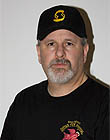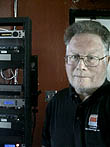|
|
This topic comprises 3 pages: 1 2 3
|
|
Author
|
Topic: OHHH, Canada!
|
Tim Reed
Better Projection Pays

Posts: 5246
From: Northampton, PA
Registered: Sep 1999
|
 posted 10-25-2003 11:02 PM
posted 10-25-2003 11:02 PM




Well, I was in Ontario this week, hauling freight. Very nice, I must say. That's the first time I've ever been in the country, and everyone I came into contact with was very pleasant. (Better than at a lot of US shippers, where the dock workers act like you're an interruption to their day!) I was in Kitchener and Pickering (Gord, I thought about you when I was going through Toronto! And Daryl, in Hamilton.)
While in the province, I noticed a few things that I just have to ask our Canadian FT'ers about...
1) What does QEW stand for?
2) What's with the crown on the route signs? Is it the Queen of Canada or something?
3) Who is Tim Horton, and why would I want to eat at his place?
4) What's with the "Eh?" Why does everybody say it?
5) How come the AMC theatres up there aren't called CMC? I noticed the AAA motor club is CAA.
6) Cool! An actual highway roadsign for a nudist colony on Route 6!
7) Wow! Is that a real shipwreck on the east side of the QEW at St. Catherines?
8) Saw a manufacturer around Grimsby that said "MAXX" on the building. The typeface is the exact same style as used with IMAX. Is this a sister company? Anyone?
9) Fix the currency. Having to offer an exchange rate for USD at every store and McDonald's must be a terrible aggravation, to say nothing of the additional workload.
10) Don't think I didn't notice the maple leaf in the McDonald's "M" up there... hey, you all didn't invent McDonald's, WE did!
11) Give up the km/h and all the metric stuff. Everything else up there you all got from here, anyway, so why not use the measurement system, too?
![[Razz]](tongue.gif)
Seriously, I enjoyed my stay there and look forward to returning soon (Although I could do without going through customs in and out.)
| IP: Logged
|
|
|
|
|
|
Rick Long
Jedi Master Film Handler
Posts: 759
From: Toronto, Ontario, Canada
Registered: Nov 1999
|
 posted 10-26-2003 01:21 AM
posted 10-26-2003 01:21 AM




(1) QEW stands for Queen Elizabeth Way, in honour of Her Majesty.
(2) The crown stands to indicate that this in one of "Her Majesties, Highways" (In practice, it means that this road is maintained by funds from the Federal (rather than Provincial) government.)
(3)Try it, you'll not go back to Krispy Kream".
(4) We DO NOT all say that. eh?
(5) AMC - who knows? CAA - Canadian Auto Club.
(6) Sorry, its clothed for the season.
(7) No, it was towed there in hopes of opening it for a sea-food restraurant, but it never materialized.
(8) Not a clue.
(9) The way the US dollar is dropping you will probably match us soon.
(10) MCDONALD? You SURE he was a yank?
(11) I grew up with Imperial measures. We converted to metric in the late 60's. It is SO much better than Imperial. From selecting wrench sizes to ordering lumber, Metric has got it hands down.
| IP: Logged
|
|
|
|
|
|
|
|
Stephen Furley
Film God

Posts: 3059
From: Coulsdon, Croydon, England
Registered: May 2002
|
 posted 10-26-2003 06:44 AM
posted 10-26-2003 06:44 AM




Michael wrote:
quote:
Tim, you maight have overlooked the fact that the rest of the civilized world uses the metric system. It would be far better for the exportability of US products if they adopted it too. I was told the conversion was started in the 70s, but then reversed in the 80s.
I have to agree with this. The SI is not perfect, but it's a lot better than the alternatives. We went metric about thirty years ago, and I would never want to go back. There are just a few things which are still in imperial units, and some of them are rather odd. Distances on roads are still in miles, and speed limits are in MPH; I think speedometers are now dual calibrated. On the railways it's miles and chains ![[Eek!]](eek.gif) (80 chains to a mile (80 chains to a mile ![[Confused]](confused.gif) ) on the main network, but the newer light rail systems, and I think the London Underground, use km. Beer from a cask is sold in pints, but bottles and cans are metric. Milk in bottles, either glass ones delivered by the milkman, or plastic ones bought from a shop is in pints, but in cardboard cartons it's in litres, why? ) on the main network, but the newer light rail systems, and I think the London Underground, use km. Beer from a cask is sold in pints, but bottles and cans are metric. Milk in bottles, either glass ones delivered by the milkman, or plastic ones bought from a shop is in pints, but in cardboard cartons it's in litres, why? ![[Confused]](confused.gif)
I understand that the US came very close to adopting the metric system long ago, around civil war time I think, but the proposal was narrowly defeated at that time.
What's wrong with the SI? Not a lot. A unit of mass really shouldn't be called a kilogram, or kilo anything else for that matter, but the old cgs system was just as bad, using the cm as the basic unit of length. The litre, which seems to be a redundant unit, as originally defined, was not quite equal to 1000 cm3. The SI units were originally defined in terms of physical standards, such as the standard metre bar, with all the problems that involves, such as ony existing in one place at any one time, and liability to change or damage, but these have now been replaced by absolute, constant standards. The main Imperial units were re-defined some time ago in terms of their SI equalivants. If you measure something in yards, and trace back through the standards used to make that measurement, you no longer end up at the Imperial stand yard, as a metal bar somewhere, but at a number which is some exact part of a metre. If you measure something in yards you are really measuring it it metres, or rather some fraction thereof. Why not use the real thing directly?
So what's wrong with the old system? Well, for a start, it's not really a system, just a lot of odd, unrelated units, ok if you want to go and buy a pound of carrots, not so good when you need to start making calculations. Then there's the problem of different units with the same name. US gallons or Imperial ones? Avoirdupois ounces, or apothecaries ones? What about troy ounces, are they the same as apothecaries or not? And no, I couldn't remember how to spell avoirdupois, I had to look it up. Let's stop this nonsense, there's too much opportunity for confusion and error.
I recently bought a book of photographic formulae, some of the measurements were in drams, minims (sp?) I don't even know what they are, and other obscure units. This was a newish book, some of the formulae were old, but some quite recent; do people really still use these units? Thankfully metric quantities were also given.
A couple more examples. Small drills, up to half inch, used to come in three series; 1/16 inch to 1/2 inch x 1/64 inch steps, No. 80 to 1, and A to Z. The number and letter sizes provided intermediate sizes between the 1/64 inch steps. No. 80 was the smallest, Z was the largest and A was slightly larger than a No. 1. E was exactly equal to 1/4 inch, but all the others were odd sizes. You are going to finish a hole with a 7/32 inch hand reamer; what size drill should you use? A drawing calls for a W drill, but you don't have a letter set, what is the nearest fractional or metric size to it? Is it close enough? You break your 27/64 inch drill, but you have a full set of letter sizes, what is the nearest letter size, and is it within tolerance for the job, considering the tolerance on the size of hole which a drill of some stated size will make anyway. The situation improved somewhat when the number and letter series were both replaced by a new series in decimal fractions of an inch, but it's all much simpler in metric.
Then there are paper sizes. Most technical documentation I get now comes as PDF files on CD or from the Internet. Mosst of it is formatted for Letter size paper. I can't get that here, must documents will print on A4, but there are a few that won't, I had to bring a couple of reams of letter size paper back with me last time I came over. Want something bigger than Letter, well there's Legal. How big is it? Goodness knows. How does it relate to Letter? Probably not at all. We used to have similar, but not the same, odd sizes, which were phased out in the early '70s. Now consider the ISO sizes. Its all based on a sheet size of 840x1188mm, known as A0. That may not sound very sensible, but wait a minute. An A0 sheet has an area of one square metre (nice round number) and the sides are in the ratio of 1 to sqrt(2). So what? Cut the sheet in half, and what have you got, two sheets A1 size. Cut one of those in half to get an A2 sheet, etc. etc. A4 is 210mmx297mm, about 8 1/4x11 3/4 inches, quite close to letter size. A5 is often used for handbills, A6 for postcards, A8 for compliment slips etc. The great thing is that all thest sizes are the same shape. Need to enlarge or reduce a document? No problem. Need to produce an A4 size booklet? Print it on A3 paper and fold it in half. Need some A6 paper? Take a pack of A4 and cut it in half each way. Isn't life simple? Need an intermediate size, say half way between A5 and A4? No problem, it's called B5. There's a whole series of 'B' sizes, but they're not used that much. Need an envelope to put an unfolded A4 sheet in? It will need to be slightly larger than A4. Guess what it's called; C4.
Of course, you may sometimes want a different shape. Some books are a squareish shape, 2/3 A4, and cheque books are 1/3 A4. All these are standard sizes, and a printer or paper merchant would have no problem if you specified any of them. Apart From the A, B and C sizes, there are two others; RA and SRA. These are untrimmed sizes, normally found from RA2 and SRA2 upwards. The RA series allows for a few mm of trimming to produce an A size finished job, the RA series has a slightly larger trim for work where the print has to bleed at the edge of the sheet. That's it; a vast range of sizes from one standard sheet and a few simple rules for dividing it. If you need to go larger then 2A is twice the size of A0, etc. When you get used to it it's all incredibly simple to work with.
I think the main reason we resisted converting for so long was simply NIH (not invented here). I'm old enough to remember when we used the old imperial units almost exclusively, and I'd never want to go back.
There is obviously some cost involved in the conversion, but when just about all of the rest of the world does it a different way, and that way is better, there's a pretty good case for converting.
By the way, what gauges of film do you run in America? ![[Wink]](wink.gif) Those of you still running carbon arcs, what diameter are your carbons? Those of you still running carbon arcs, what diameter are your carbons? ![[Wink]](wink.gif) Strange that the lengths are in inches though. I also saw some carbonated drinks in 2 litre bottles while I was over there last time. Strange that the lengths are in inches though. I also saw some carbonated drinks in 2 litre bottles while I was over there last time.
| IP: Logged
|
|
|
|
|
|
|
|
|
|
|
|
Stephen Furley
Film God

Posts: 3059
From: Coulsdon, Croydon, England
Registered: May 2002
|
 posted 10-26-2003 02:21 PM
posted 10-26-2003 02:21 PM




Gerard, I knew what letter size was, but not legal, I just knew that it was bigger than letter. Letter works out at a ratio of about 1.29:1, while leagal is about 1.65:1. If you fold a sheet of letter it becomes about 1.55:1, quite different to the original sheet.
Years ago, our 'office' paper sizes, for typing, duplicating etc. were quarto, which was 8x10 and foolscap, which was 8x13; both were replaced by A4 from about 1970. However, there were several 'foolscap' sizes, for different types of papers, and, at one time we could buy three different quartos, 'normal' 8x10, 'American quarto' which is what you now call letter, and 'metric quarto', which was 8.25x10. The latter two sizes were not very common. The ISO series sizes really were a great improvement. We don't have the three ring binders which you use, our most common type for A4 papers has only two rings, at 8cm spaninh, and it's horrible, the pages move about too much, and get torn. There was an older standard at 7cm spacing, which was even worse. We can also get four ring binders, with all holes at 8cm spacing, and these are much better. I use them for almost everything now.
I know full plate is 6.5x8.5, but, if I remember correctly, half plate is not half of that, but 4.75x6.5; is that correct? Quarter plate really is a quarter of full plate, 4.25x3.25, isn't it; the size of the medium sized Speed Graphic. I believe you are more consistant than us, in always putting the smaller dimension first, we tend to refer to 5x4, 10x8 and 20x16, but 10x12 and 11x14. Photographic sizes are one of the few things where we still use inches, it's easier to say 5x4 than 10.2x12.7, which is how the boxes are marked now.
There are three plate/film sizes, which will all fit the same camera back, but each needs a different holder, these are half plate, 5x7" and 13x18cm. No wonder manufacturers don't want to make them, and shops don't want to stock them when what is already a very small market is split between three different sizes. A 5x4 camera will also take 9x12cm film, but again, different holders are required. 9x12 is not very common here, put I bought a large quantity of slightly outdated Fuji Astia very cheaply in this size, and managed to find three holders to fit. It's quite a nice format, a slightly wider ratio than 5x4.
I think the old sizes are still used for posters, but I haven't got a clue what size a 'twelve sheet', or whatever poster is.
I remember once having to cut a 5/8" left hand B.S.P (british standard pipe) thread for a connection to a propane cylinder, on a normal metric lathe. It is a pain to do, you have to set up a weird gear train, and once you start you can't disengage from the lead screw, or it won't pick up again correctly for the next pass, even with a screw cutting dial on the machine, you have to pull the tool back, stop and reverse the spindle to get back for the next pass. Give me an all-metric system any day.
I have just had an interesting thought. There has been a lot of talk of Concorde in the past few days. At the time it was designed Britain was still making engineering drawings in imperial units, whereas France was, of course, using metric. I wonder how they managed? Trying to use both systems sounds like a bad idea. I suspect that the whole project was done in metric, partly because I think it would have been easier to persuade the British to work in metric than the French to work in imperial, metric units had already been in use in Britain for many years for certain specialised purposes, partly because the 'new, modern' metric system, which most of the rest of the world had been using for a long time of course, fitted in with the modern image of the plane, and partly because although the French and British were, in theory, equal partners in the project, in reality it was very much French led.
However it was done, it was a fine bit of engineering.
| IP: Logged
|
|
|
|
|
|
All times are Central (GMT -6:00)
|
This topic comprises 3 pages: 1 2 3
|
Powered by Infopop Corporation
UBB.classicTM
6.3.1.2
The Film-Tech Forums are designed for various members related to the cinema industry to express their opinions, viewpoints and testimonials on various products, services and events based upon speculation, personal knowledge and factual information through use, therefore all views represented here allow no liability upon the publishers of this web site and the owners of said views assume no liability for any ill will resulting from these postings. The posts made here are for educational as well as entertainment purposes and as such anyone viewing this portion of the website must accept these views as statements of the author of that opinion
and agrees to release the authors from any and all liability.
|

 Home
Home
 Products
Products
 Store
Store
 Forum
Forum
 Warehouse
Warehouse
 Contact Us
Contact Us




 Printer-friendly view of this topic
Printer-friendly view of this topic





![[Razz]](tongue.gif)




![[Wink]](wink.gif)


![[thumbsup]](graemlins/thumbsup.gif)
![[Frown]](frown.gif)

![[Eek!]](eek.gif) (80 chains to a mile
(80 chains to a mile ![[Confused]](confused.gif) ) on the main network, but the newer light rail systems, and I think the London Underground, use km. Beer from a cask is sold in pints, but bottles and cans are metric. Milk in bottles, either glass ones delivered by the milkman, or plastic ones bought from a shop is in pints, but in cardboard cartons it's in litres, why?
) on the main network, but the newer light rail systems, and I think the London Underground, use km. Beer from a cask is sold in pints, but bottles and cans are metric. Milk in bottles, either glass ones delivered by the milkman, or plastic ones bought from a shop is in pints, but in cardboard cartons it's in litres, why? 







